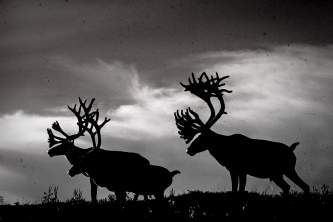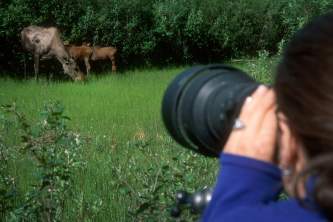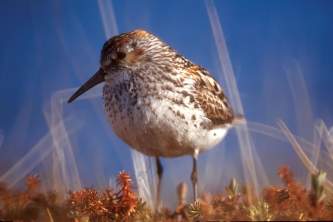The Best Birding Locations in Anchorage
Anchorage offers excellent birding opportunities, especially during spring and fall migration periods. Local wetlands and water bodies provide a major stop for species winging to and from nesting sites across the whole Arctic. The city’s coast—running from Ship Creek around Point Woronzof to immense flats and Potter Marsh—is especially productive.
“This narrow strip of valuable habitat along Cook Inlet supports some of the greatest numbers and diversity of birds in the Anchorage area,” says Audubon Alaska in an introduction to its coastal checklist. “Bird enthusiasts have recorded approximately 220 species, of which about 160 occur annually either as migrants or breeders.”
A few of the most exotic migrants, like Arctic terns and trumpeter swans, spend the summer locally. But you will also see plenty of rare visitors, plus breeding geese, ducks, swans, gulls and shorebirds. And then there are the year-round residents—ravens, bald eagles, magpies, chickadees, and redpolls—all tough, shrewd and supremely adapted to survive local winters.
Where should you go first?
Show Map
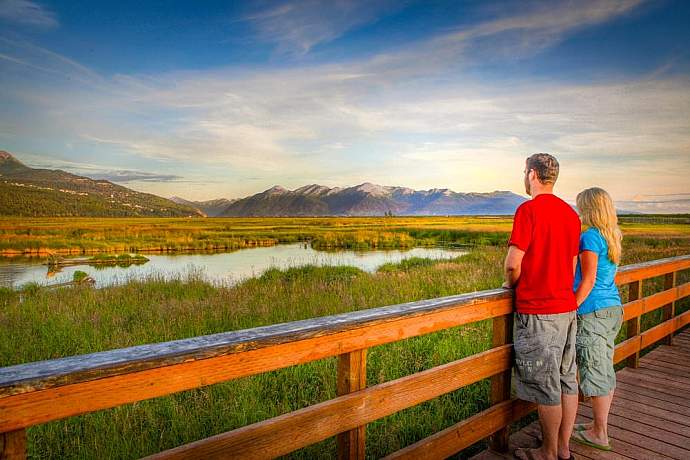
Potter Marsh
Probably Anchorage’s best birding venue. This 564-acre fresh-water marsh stretches along the Seward Highway for nearly two miles, forming a wetland maze between Turnagain Arm and the foot of the Chugach Mountains. At least 130 species of migratory and nesting birds converge on the marsh’s network of ponds and channels, often only yards from a handsome 1,550-foot boardwalk extending deep into the habitat. Highway pullouts provide parking at several key pools, sometimes concentrating a dozen photographers harvesting images of nesting trumpeter swans or Arctic terns.
Notable species include bald eagles, Canada geese, Arctic terns, trumpeter swans, red-necked grebes, northern pintails, canvasback ducks and northern harriers. Don’t limit yourself to birds either! The boardwalk system makes the marsh one of the most accessible wildlife viewing venues in the state. Watch for moose, muskrats, land otters and, if lucky, a glimpse of a black bear in the brush fringes early or late. Plus coho, pink and Chinook salmon fin in the clear water of Rabbit Creek during spawning runs.
Getting There
From Anchorage, follow the Seward Highway south past the Rabbit Creek Road interchange to the panoramic view of Turnagain Arm. Take the Potter Marsh exit to the east (toward the mountains) and follow the road south to a very big parking lot by the boardwalk. A second parking area is two miles south where the marsh ends at Potter Valley Road. Two small pullouts lie in between.
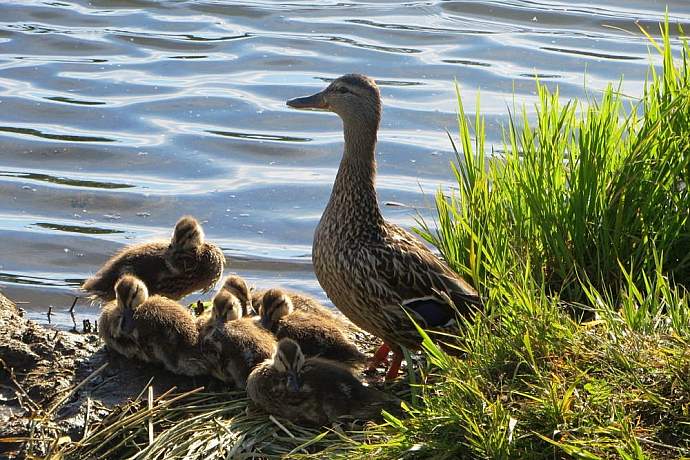
Westchester Lagoon
Scores of migratory waterfowl and year-round species converge every year on this 50-acre lake in a popular park where Chester Creek flows into Knik Arm. Watch for Alaska staples like bald eagles, black-billed magpies, mallards, Canada geese and gobs of gulls from ice-out to freeze-up. Migratory waterfowl passing through or building summer nests may include red-necked grebes, green-winged teal, American wigeon, Greater scaup and Sandhill cranes. Excitable Arctic terns will scold if you approach a nesting site, while tree swallows swoop and dive overhead, scarfing down mosquitoes. Two small islands often concentrate noisy flocks of mew, Bonaparte and Glaucous-winged gulls, along with Anchorage’s ubiquitous Canada geese and mallards. With a bike trail along about half of the shoreline, the lagoon has exceptional access and is very popular with birders and tour groups.
Aside from its wildlife habitat, Westchester Lagoon is one of Anchorage’s civic gems, attracting trail users of all modes, plus picnickers, paddlers during summer and ice skaters in winter. With two bike tunnels to the Tony Knowles Coastal Trail west and east, the lagoon is also a great base for walks exploring Anchorage’s Knik Arm coast.
Getting There
Located at 1824 W. 15th Avenue. If traveling north on L Street, turn west on 13th Avenue, enter the neighborhood and work around the block containing Inlet View Elementary School to 15th Avenue and head west. If traveling south on L Street, exit right at the light on 13th Avenue or take the next at 15th Avenue. If traveling west on 15th Avenue, don’t go all the way to the end. Turn north on L Street, then west on 13th Avenue into the neighborhood.
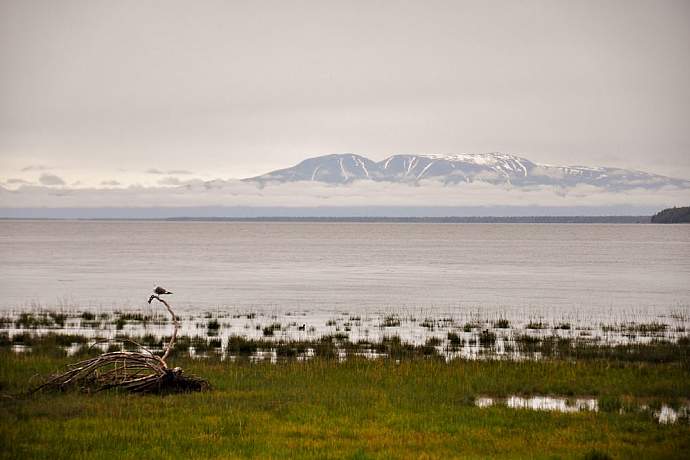
Tony Knowles Coastal Trail
The coastal flats rimming Anchorage’s Knik Arm features a wild, bird-rich habitat that extends west and south along the coast to merge with a state wildlife refuge along Turnagain Arm. The dramatic, tidally flushed northern zone has exceptional access for birding—the paved Tony Knowles Coastal Trail runs along the shore for a dozen miles from downtown Anchorage to Point Campbell in Kincaid Park. The first couple miles of the trail on both sides of Westchester Lagoon are almost on-grade with the flats, a literal step or two away from world-class viewing of migrating shorebirds and waterfowl.
Best bet? Try the Fish Creek Estuary, located on the Coastal Trail about a half mile south of the Westchester Lagoon parking area (about 350 yards beyond the southern tunnel beneath the railroad.) The creek winds through a tidal marsh, passes beneath the trail bridge, and winds off into the flats. The immediate habitat draws more than 100 species of shorebirds and migrants, including sandpipers, ducks, geese, sandhill cranes and plovers. The area can be exciting for birders, since it can draw species straying far from their normal ranges.
Getting There
From Westchester Lagoon, stroll or bike on the Tony Knowles Coastal Trail through the southern tunnel beneath the Alaska Railroad. Continue another 350 yards to the Fish Creek bridge.
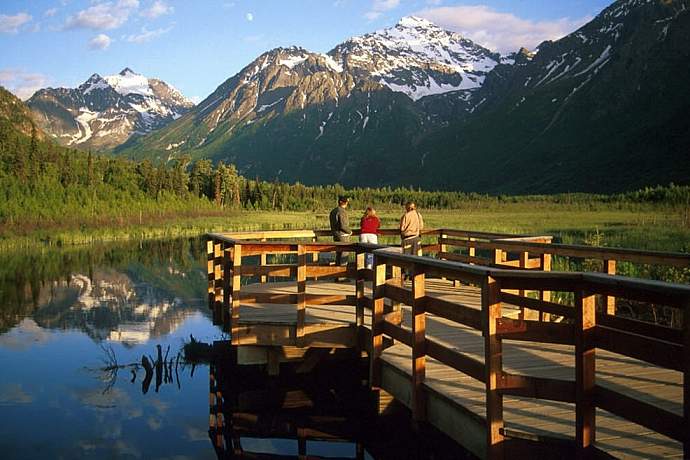
Eagle River Nature Center
If you’re looking for forest birds, as well as Alaskan residents, you can’t go wrong with a stroll along the maintained trails surrounding the Eagle River Nature Center. Set in the riparian forest 12 miles up Eagle River Valley, this non-profit visitor center is basically a natural history museum tucked inside a log cabin. You will find displays, expert advice, guided hikes and information about the flora, fauna and trails of Eagle River Valley. The organization regularly schedules hikes and educational programs completely focused on birding and photographing birds. (Contact ERNC for details or call 907-694-2108.)
For a great self-guided hike, try the .75-mile Rodak Trail—a mostly flat route that loops through forest and marsh, and includes a deck overlooking a beaver pond. Recognized as an important educational trail by state parks, Rodak loop requires dogs to remain on leash and prohibits any disturbance of plants. Watch for woodpeckers, sparrows, warblers and thrushes—including the often elusive Varied thrush with a distinctive trill that sounds like a ringing telephone. Bald eagles soar across the sky, while dark-eyed juncos flit along the forest floor.
Getting There
Take Eagle River Road 12 miles east into the Chugach Mountains to the center. (32750 Eagle River Road.) $5 parking fee.
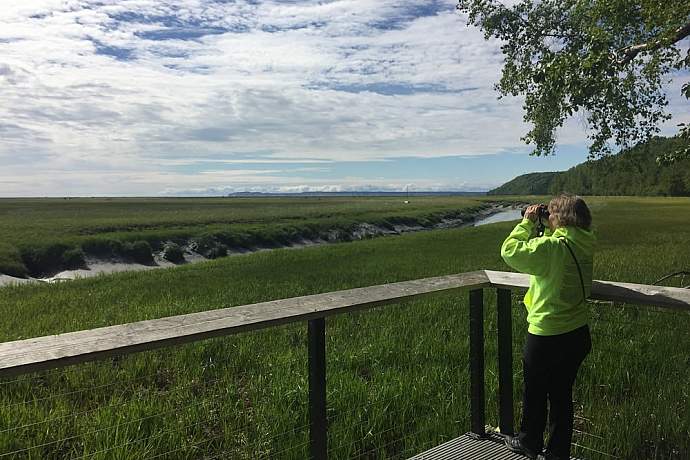
Campbell Creek Estuary Natural Area
For an intimate encounter with the Anchorage Coastal Wildlife Refuge, this new park overlooking the Campbell Creek estuary provides unique access to some of Anchorage’s most dramatic bird concentrations and habitat. More a nature preserve than a park, the 60-acre natural area features interpretive panels and a loop trail through an upland meadow with a panoramic overlook of the vast coastal flats along Turnagain Arm. A trail leads down the bluff to a deck closer to where the creek meanders across a grassy expanse toward the ocean. Another spur trail leads to a blind overlooking sandhill crane breeding and nesting areas—the “windows” are arrayed at all levels, with easy viewing for both kids and tall persons.
Spring and fall might be the best times, when the flats host hundreds of migrating birds from dozens of species, including vast flocks of snow geese and cranes. But don’t hesitate to visit during any summer day. Mew gulls and Northern harriers might wing over the flats, while warblers, thrushes and sparrows flit in the forest and through the meadow. The blind usually offers views of active sandhill crane nests. Bring binoculars and watch as a crane slowly periscopes its head above the sedges to scan for danger!
Getting There
9520 Selkirk Drive. Take Dimond Boulevard west past Jewel Lake Road and turn south on Edinburgh Drive for about a quarter mile and turn right on Selkirk. The park, with 10 spaces and a toilet, is right there. Dogs are prohibited in the park.
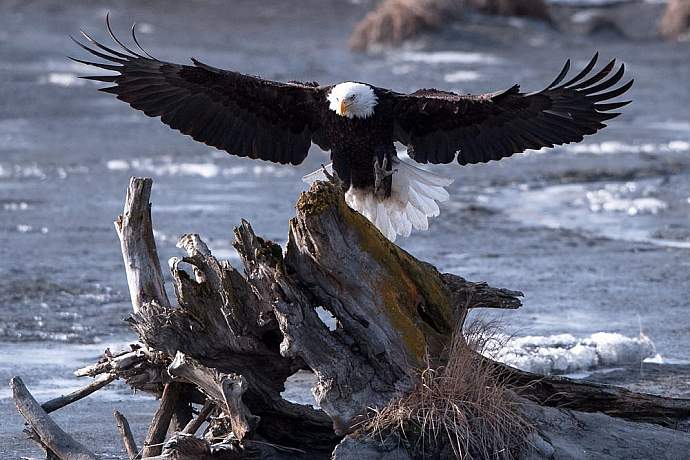
Turnagain Arm
Any pullout or trailhead along Turnagain Arm southeast of Anchorage could deliver a stunning panorama with interesting views of active birds. The Seward Highway runs nearly 50 miles along the shore, from Potter Marsh on the outskirts of the Anchorage Bowl to head of the fiord. Bald eagles are easy to see on exposed mudflats when salmon and hooligan are running: watch for the distinctive white head on black body. It’s not unusual to see three or four at a glance. Stunning trumpeter swans nest in ponds just off the road, along with terns and geese. Check the wetlands south of the highway as it curves toward the Kenai Peninsula. For a summer treat, park at the pullout at Ingram Creek (just before the highway starts climbing to Turnagain Pass) and take the path underneath the highway bridge. Most years, a small colony of cliff swallows will have built mud nests in the steel beams. Only yards away, you can watch individual swallows peek from their gourd-shape homes and swoop off to find food.
Don’t have a lot of time? Go straight to Bird Point at Mile 96.5. Part of Chugach State Park, the wayside features viewing decks with scopes as well as unofficial trails into a majestic spruce-birch forest. The point bulges out into Turnagain Arm almost half a mile, making it a great place for looking for beluga whales in the ocean and Dall sheep on the 3,000-foot face of Penguin Ridge. But it’s also an ideal spot to glimpse bald eagles, common ravens and gulls of all sorts. Black-billed magpies will boldly visit the viewing decks and parking area, while much more elusive Varied thrush and Hermit thrush forage and nest in the mature spruce forest. Look for shorebirds in the salt marshes.
Getting There
Drive south on the Seward Highway past Potter Marsh. Bird Point requires a state parking pass or a $5 fee, but most waysides are free.
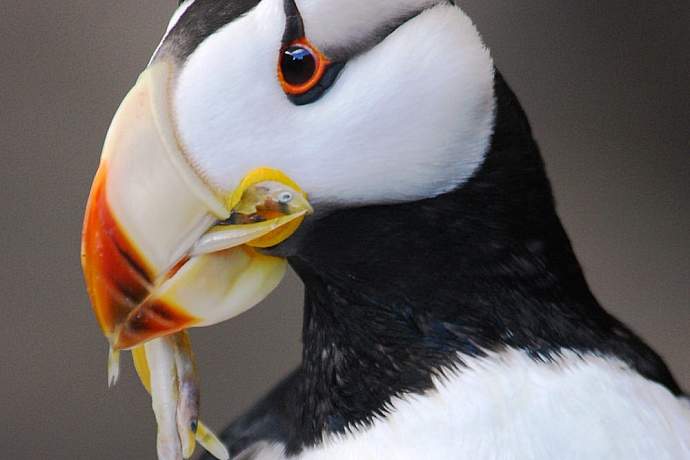
Guaranteed Viewing
- Dozens of birds—many rescued from the wild after being orphaned or injured—can be seen on display at the Alaska Zoo on O’Malley Road and at the Alaska Wildlife Conservation Center at the head of Turnagain Arm in Portage. These facilities may offer the easiest way to experience that hairs-are-standing-up moment that comes when you are staring down a bald eagle or owl from a couple feet.
- The Bird Treatment and Learning Center—an avian rehabilitation clinic with two locations in Anchorage—often puts on programs with the chance to see one of their recovered patients up close. (Watching a rehabbed bald eagle take wing at a release near Potter Marsh is a kick not to be missed.) The BTLC is in the process of building a new facility adjacent to Potter Marsh (2018) and will soon become more accessible.
- Finally, the Alaska SeaLife Center in Seward features a multistory habitat for diving seabirds, with both above-water and below-the-surface viewing. Watching puffins “fly” underwater to snatch submerged snacks can be astounding.

